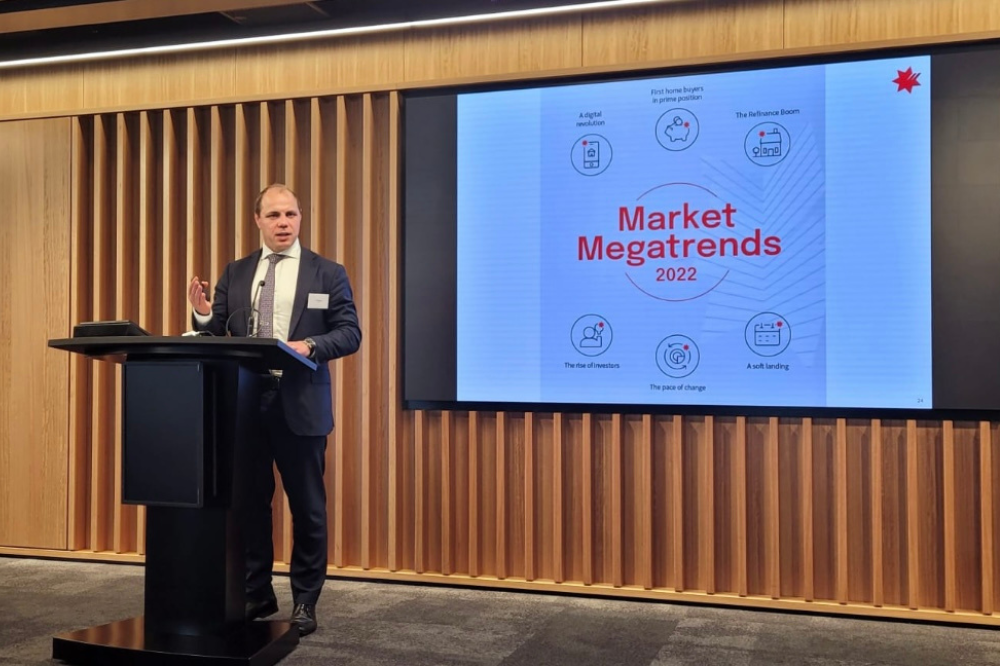A new NAB report has revealed six megatrends that mortgage brokers should have on their radar during the final months of 2022 and looking ahead for next year.
On Friday, October 21, NAB launched Market megatrends 2022: Uncovering the opportunities for brokers, a practical guide to navigating Australia’s fast-moving property market.
In partnership with CoreLogic, the companies have identified six key market forces or “megatrends” that are shaping the broker marketplace today and into the future. Insights for the report were provided by NAB group chief economist Alan Oster and NAB head of behavioural and industry economics Dean Pearson, as well as data from CoreLogic.
The event was held at NAB’s Sydney office and hosted by Phil Waugh (pictured above left), NAB executive – broker distribution, and Eliza Owen (pictured above right), CoreLogic head of research Australia.
Owen and Waugh discussed the following property and lending megatrends:
The pace of change
As property markets reacted strongly and swiftly to extremes in economic activity over the COVID period, conditions are now returning to pre-COVID-19 norms.
Read more: Housing price downturn hits the regions – CoreLogic
“The social and economic progression beyond COVID-19 will likely extend to housing market conditions,” Owen said.
“This is where transaction activity and price movements may see less volatility in the years ahead.”
Owen said the housing market was experiencing a downswing in areas.
“The cash rate is rising at the fastest pace since the early 1990s and we are now living through the fastest housing downturn on record,” she said.
“Coming out of lockdowns, we see a normalisation in house prices and values.”
A soft landing
Owen said tailwinds such as returning migration, high rental demand, strong mortgage serviceability and fewer listings might already be stemming property price falls.
“Surging home values in the years preceding the current market slump means gains made through the upswing are unlikely to be fully eroded,” she said.
Owen said extremities in the economy and housing market influenced the pace of change.
“The Australian housing market has experienced a 30% upswing in home values in less than two years,” she said.
“In 2021 there were approximately 620,000 housing transactions which was the highest volume on record, coupled with auction volumes and clearances rates at an all-time high.”
Read next: NAB offers financial support to flood-impacted customers
The rise of investors
Owen said rent values rose 10% in the year to September, meanwhile gross rental yields nationally rose 3% from January to September.
“Rising yields coupled with lower purchase prices could create opportunities for the investor segment of the market,” she said.
Owen said house rent values lifted 10.2% in the 12 months to September 2022.
“We have seen extreme growth in rentals as units have lifted 11.8% in the same period across capital cities and regions,” she said.
“These increases are due to multiple factors including the spreading out of tenants across markets as people wanted more space during COVID-19. People opted for a home office in the second bedroom rather than a housemate. There was also a lot of sell-off of investment properties as people were cashing in on record highs, which in turn constricted rental supply.”
First home buyers in prime position
Owen said vendors discounting from the listing price increased to 4.2% in the three months to September. Meanwhile, time on market increased to 33 days up from a recent low of 20 days.
“These trends indicate a shift from a sellers’ market to a buyers’ market which favours first-time buyers,” she said.
“Falling home prices and extended government guarantees are supporting first home buyers to take their initial steps onto the property ladder.”
The refinance boom
Waugh said refinance volumes reached almost $19bn in August which was in part due to the fixed rate expiry bubble which would continue to flow through into mid-2023.

“NAB is backing brokers by offering appropriate rates and discounts for refinance customers and fast, seamless processes on like-for-like refinancing,” Waugh said.
“The challenge for all lenders in this competitive market is to provide customers with attractive loan propositions while remaining sustainable from a business perspective. Debt-to-income ratios are top of mind, with a focus on DTI ratios that are less than six times.”
Waugh said cost of living pressures continued to surface, with no signs of slowing as people expected.
“NABs measure of consumer sentiment has consistently shown that Australians are more resilient than other measures than consumer confidence predicts, which is a positive result,” he said.
“Consumers however are feeling the pinch with six in 10 Aussies switching to cheaper branded products and one in two more cautious of their spending”
A digital revolution
Waugh said automation and technology, along with process improvements and product simplification were making the end-to-end home lending process quicker, simpler and smarter.
“We continue to invest to deliver simpler, more digital experiences for brokers and customers,” he said.
“We have started deploying our Simple Home Loan technology to the broker market and we are giving decisions in minutes, not days. The ability for brokers to give an answer on the spot is powerful, because if an answer can’t be provided on the spot, the majority are being given within 24 hours.”
NAB’s report also identifies the long-term changes brokers and their customers are facing, along with features commentary from experienced brokers who share their take on how the megatrends were rewriting the way they do business.
“Megatrends are powerful, transformative forces of change and are typically longer term in nature – making their impact all the more significant,” Waugh said.
“While this report helps to identify the latest opportunities, cost of living pressures continue to surface. While most customers are telling us they are coping okay, we know this isn’t the same for everyone.”
NAB predicts the cash rate rises will stabilise by the end of 2022 or early 2023.
“This will put a floor on the current downturn in property prices – while tailwinds to the market are already emerging which may stem price falls sooner. Property market changes and the rising rate environment have had wide-ranging impacts for brokers and customers,” Waugh said.
“While there are still plenty of opportunities, everything hinges on how customers are thinking and feeling right now. Brokers are well positioned to provide much-needed guidance to help customers navigate the market and as the bank behind the broker, NAB is here to support customers and brokers every step of the way.”


